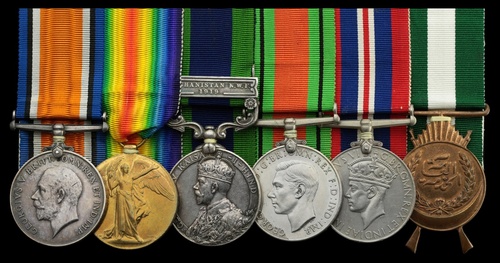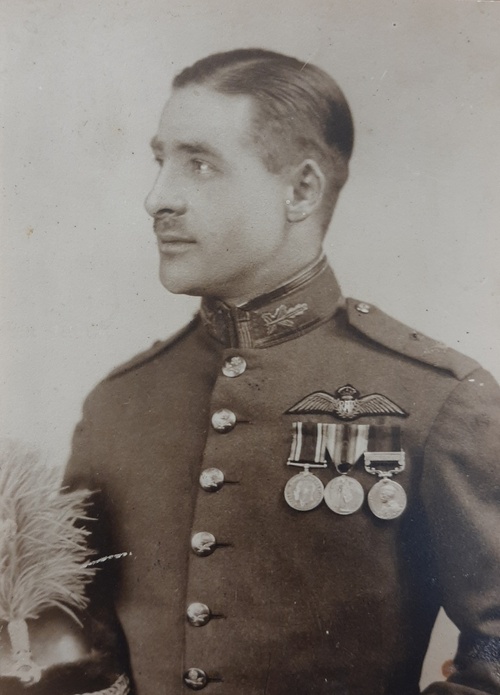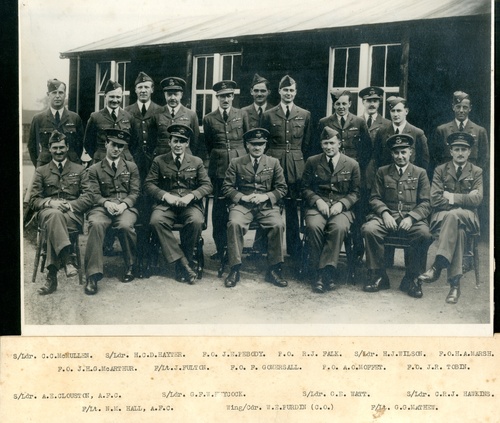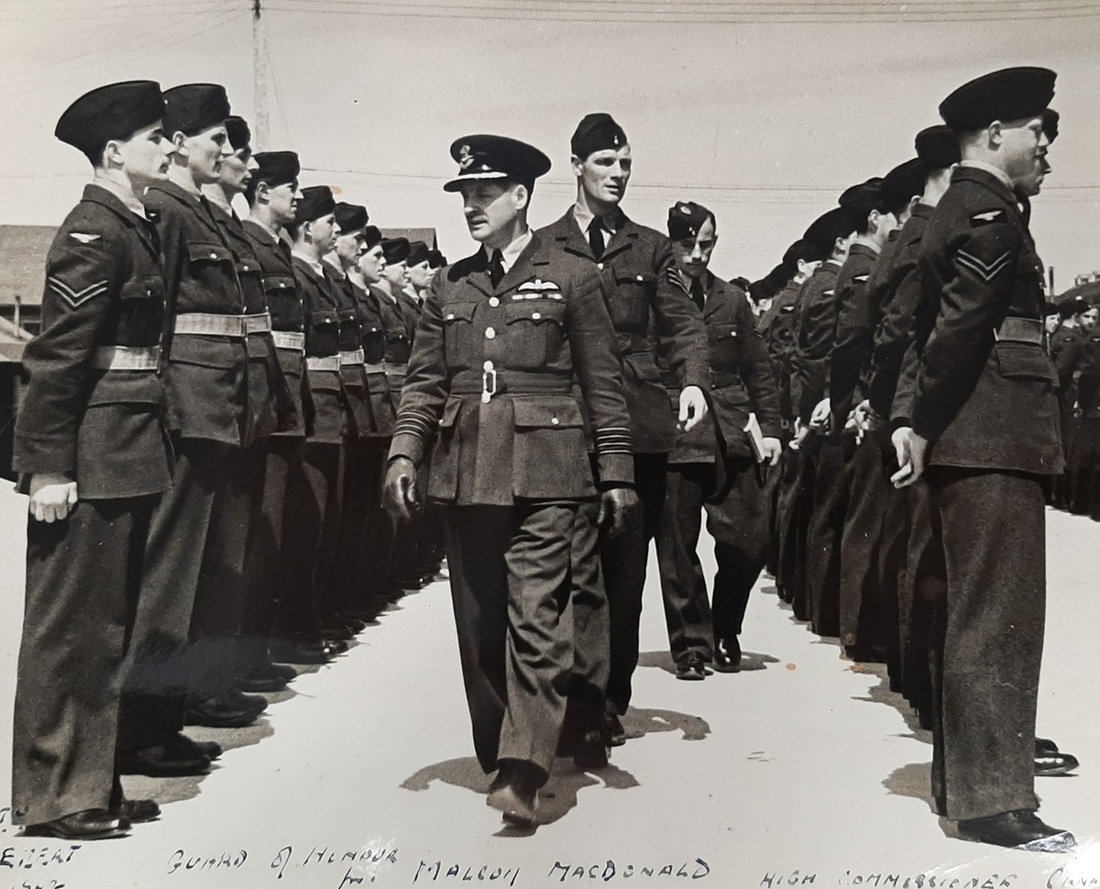Auction: 22133 - Orders, Decorations and Medals - e-Auction
Lot: 949
The remarkable Great War, Iraq and Second World War group of six awarded to a Group Captain W. E. Purdin, Royal Air Force, a founding member of the 'Farnborough Caterpillar Club', who, in his lifetime, held the record for flying the highest number of differing aircraft in the world
Joining underage to start his career as an Air Mechanic before training as an Air Gunner/Observer and working his way up to the rank of Group Captain Purdin even flew several patrols during the Battle of Britain as head of the Experimental Section, Royal Aircraft Establishment
British War and Victory Medals (Flying Officer W. E. Purdin R.A.F.); India General Service 1908-35, 1 clasp, Afghanistan N.W.F. 1919 (Flying Officer W. E. Purdin, R.A.F.); Defence and War Medals 1939-45; Iraq War Service Medal, mounted as worn, all campaign medals named unofficially, heavy contact marks to first, minor contact marks overall, very fine (6)
William Edward Purdin was born in London on 1896, the son of Thomas Purdin of 143 Kennington Street. Enlisting with the Royal Flying Corps on 3 November 1915 with the rank of Air Mechanic Class II while still only 16. Qualifying as an Air Gunner on 1 August 1917 by 17 April 1918 Purdin was posted to No. 35 Training Squadron. Commissioned on 13 August 1918 he was posted to India for service in the Third Afghan War with No. 52 Wing. While the logbooks relating to this period are missing those present do note 650 hours as Pilot and 150 as Gunner/Observer brought over from the period between April 1918-April 1922.
Posted to Duxford as an instructor he remained there until December when he transferred to No. 4 Flying Training School in Egypt, remaining there until March 1925. Transferring to No. 6 Squadron in Iraq on 14 March 1925 he was part of several bombing raids on rebel camps through April and May. During these operations Purdin experienced his first prang, suffering engine trouble on 3 August 1925 he was forced to crash land in a Wadi. Fortunately he survived, though his logbooks note that the aircraft was a write-off. Back to flying soon Purdin took part in a raid on the French controlled Syrian Border on 2 April 1926.
Returning to Britain later that year he was posted as an Instructor at No.1 Flying Training School at Netheravon. Later via a post as Flight Commander at the School of Photography he became a test Pilot with the Royal Aircraft Establishment. It was here that Purdin was to join the Caterpillar Club, while conducting an airscrew test on a Gorcock the wing collapsed and he was forced to bale out, making use of his parachute. In the process becoming the sixth of the 'Farnborough Caterpillars'. Remaining with the R.A.E. for several years he left on 6 November 1933, it was not to prove permanent however.
Posted to No 8 (B) Squadron in Aiden as Officer Commanding 'C' Flight Purdin once again began to carry out bombing operations. His log books note raids in Upper Yaffa on 22-23 November as well as 'Active Operations' in Bakri on 5, 7 and 9 February 1934. Further actions continued in this vein, as well as co-operative operations with the Camel Corps in British Somaliland, until August 1935 when Purdin was posted to Cranwell. Here he commanded No. 2 Electrical Wing at the Wireless School, also being promoted Squadron Leader on 1 October. Returning to the R.A.E. experimental section in November 1938 he re-joined it as commanding officer and was still there on the outbreak of the Second World War the next year.
Notably here the R.A.E. were not meant to be engaging the enemy but, as the Battle of Britain gained steam and Test Pilots being the breed they are, this did not stop all of them. On two occasions Purdin was forced to ground Squadron Leader (later Air Commodore) Arthur Clouston for getting into dogfights. Doing so even when the irrepressible Clouston managed to shoot down an He 111. During this time Purdin took an active part in several defence patrols himself starting in August of 1940.
Posted to Canada Command in 1941 he was to form and command No. 31 Officer Training Unit and with with the posting came advancement as he was promoted Wing Commander that same year. Purdin was further advanced to the Temporary rank of Group Captain on 11 March 1941. While here the Governor General of Canada, the Earl of Athlone visited the unit's mess, with a number of photographs and a good deal of correspondence speaking to the success of the visit. Returning to Britain in May 1943 Purdin formed No. 1 Transport Officer Training Unit and later that same year became Senior Staff Officer for No. 44 Group. Finally retiring on 26 February 1946, he was confirmed in the rank of Group Captain (retired) as a final honour. Purdin died in 1973 in Durban, South Africa, with his obituary crediting him with a world record, in his lifetime, for the number of different aircraft flown, that number being 124.
Sold together with the following archive:
(i)
His two Flying Log Books.
(ii)
A number of photographs of the recipient.
(iii)
Several group photographs including the recipient.
(iv)
A plaque stating 'Experimental Section. Royal Aircraft Establishment, May 1940.
(v)
Newspaper obituaries.
(vi)
Letters to the recipient.
(vii)
Business cards named to 'Group Captain W. E. Purdin'.
(viii)
A copy of Farnborough's Caterpillars.
(ix) A silver salver presented to the recipient by his comrades at the R.A.E.
(x)
Two commission documents.
Subject to 20% VAT on Buyer’s Premium. For more information please view Terms and Conditions for Buyers.
Sold for
£650
Starting price
£170

































